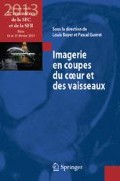Résumé
L’imagerie de coupe a vu ses indications croître de manière très importante ses dernières années dans l’évaluation des gros vaisseaux et des artères périphériques, mais également au niveau cardiaque pour l’étude non invasive de l’anatomie coronaire, du myocarde et plus récemment des valves. Nous présentons dans ce chapitre l’apport de l’imagerie de coupe dans l’évaluation du rétrécissement aortique (RAC). Nous n’aborderons pas son rôle dans le remplacement valvulaire aortique par cathétérisme (TAVI).
Preview
Unable to display preview. Download preview PDF.
Références
Alkadhi H, Wildermuth S, Plass A, et al. (2006) Aortic stenosis: comparative evaluation of 16-detector row CT and echocardiography. Radiology 240: 47–55
Bouvier E, Logeart D, Sablayrolles JL, et al. (2006) Diagnosis of aortic valvular stenosis by multislice cardiac computed tomography. Eur Heart J 27: 3033–8
Feuchtner GM, Dichtl W, Friedrich GJ, et al. (2006) Multislice computed tomography for detection of patients with aortic valve stenosis and quantification of severity. J Am Coll Cardiol 47: 1410–7
Feuchtner GM, Muller S, Bonatti J, et al. (2007) Sixty-four slice CT evaluation of aortic stenosis using planimetry of the aortic valve area. AJR Am J Roentgenol 189: 197–203
Laissy JP, Messika-Zeitoun D, Serfaty JM, et al. (2007) Comprehensive evaluation of preoperative patients with aortic valve stenosis: usefulness of cardiac multidetector computed tomography. Heart 93: 1121–5
Pouleur AC, le Polain de Waroux JB, Pasquet A, et al. (2007) Aortic valve area assessment: multidetector CT compared with cine MR imaging and transthoracic and transesophageal echocardiography. Radiology 244: 745–54
Lembcke A, Kivelitz DE, Borges AC, et al. (2009) Quantification of aortic valve stenosis: head-to-head comparison of 64-slice spiral computed tomography with transesophageal and transthoracic echocardiography and cardiac catheterization. Invest Radiol 44:7–14
Kupfahl C, Honold M, Meinhardt G, et al. (2004) Évaluation of aortic stenosis by cardiovascular magnetic resonance imaging: comparison with established routine clinical techniques. Heart 90: 893–901
Malyar NM, Schlosser T, Barkhausen J, et al. (2008) Assessment of aortic valve area in aortic stenosis using cardiac magnetic resonance tomography: comparison with echocardiography. Cardiology 109: 126–34
Pouleur AC, le Polain de Waroux JB, Pasquet A, et al. (2007) Planimetric and continuity equation assessment of aortic valve area: Head to head comparison between cardiac magnetic resonance and echocardiography. J Magn Reson Imaging 26: 1436–43
Puymirat E, Chassaing S, Trinquart L, et al. (2010) Hakki’s formula for measurement of aortic valve area by magnetic resonance imaging. Am J Cardiol 106: 249–54
Caruthers SD, Lin SJ, Brown P, et al. (2003) Practical value of cardiac magnetic resonance imaging for clinical quantification of aortic valve stenosis: comparison with echocardiography. Circulation 108: 2236–43
Defrance C, Bollache E, Kachenoura N, et al. (2012) Évaluation of aortic valve stenosis using cardiovascular magnetic resonance: comparison of an original semiautomated analysis of phase-contrast cardiovascular magnetic resonance with Doppler echocardiography. Circ Cardiovasc Imaging 5: 604–12
Garcia J, Marrufo OR, Rodriguez AO, et al. (2012) Cardiovascular magnetic resonance evaluation of aortic stenosis severity using single plane measurement of effective orifice area. J Cardiovasc Magn Reson 14: 23
Cueff C, Lepage L, Boutron I, et al. (2009) Usefulness of the right parasternal view and non-imaging continuous-wave Doppler transducer for the evaluation of the severity of aortic stenosis in the modern area. Eur J Echocardiogr 10: 420–4
Messika-Zeitoun D, Aubry MC, Detaint D, et al. (2004) Évaluation and clinical implications of Aortic Valve Calcification by Electron Beam Computed Tomography. Circulation 110: 356–62
Rumberger JA, Brundage BH, Rader DJ, Kondos G (1999) Electron beam computed tomographic coronary calcium scanning: a review and guidelines for use in asymptomatic persons. Mayo Clin Proc 74: 243–52
Cueff C, Serfaty JM, Cimadevilla C, et al. (2011) Measurement of aortic valve calcification using multislice computed tomography: correlation with haemodynamic severity of aortic stenosis and clinical implication for patients with low ejection fraction. Heart 97: 721–6
Monin JL, Quere JP, Monchi M, et al. (2003) Low-gradient aortic stenosis: operative risk stratification and predictors for long-term outcome: a multicenter study using dobutamine stress hemodynamics. Circulation 108: 319–24
Hachicha Z, Dumesnil JG, Bogaty P, Pibarot P (2007) Paradoxical low-flow, low-gradient severe aortic stenosis despite preserved ejection fraction is associated with higher afterload and reduced survival. Circulation 115: 2856–64
Vahanian A, Baumgartner H, Bax J, et al. (2007) Guidelines on the management of valvular heart disease: The Task Force on the Management of Valvular Heart Disease of the European Society of Cardiology. Eur Heart J 28: 230–68
Weidemann F, Herrmann S, Stork S, et al. (2009) Impact of myocardial fibrosis in patients with symptomatic severe aortic stenosis. Circulation 120: 577–84
Dweck MR, Joshi S, Murigu T, et al. (2011) Midwall fibrosis is an independent predictor of mortality in patients with aortic stenosis. J Am Coll Cardiol 58: 1271–9
Peltier M, Trojette F, Sarano ME, et al. (2003) Relation between cardiovascular risk factors and nonrheumatic severe calcific aortic stenosis among patients with a three-cuspid aortic valve. Am J Cardiol 91: 97–9
Gilard M, Cornily JC, Pennec PY, et al. (2006) Accuracy of multislice computed tomography in the preoperative assessment of coronary disease in patients with aortic valve stenosis. J Am Coll Cardiol 47: 2020–4
Reant P, Brunot S, Lafitte S, et al. (2006) Predictive Value of Noninvasive Coronary Angiography With Multidetector Computed Tomography to Detect Significant Coronary Stenosis Before Valve Surgery. Am J Cardiol 97: 1506–10
Author information
Authors and Affiliations
Corresponding author
Editor information
Editors and Affiliations
Rights and permissions
Copyright information
© 2013 Springer-Verlag Paris
About this paper
Cite this paper
Messika-Zeitoun, D. (2013). Intérêt de l’imagerie de coupes dans le rétrécissement aortique. In: Boyer, L., Guéret, P. (eds) Imagerie en coupes du cœur et des vaisseaux. Springer, Paris. https://doi.org/10.1007/978-2-8178-0435-4_20
Download citation
DOI: https://doi.org/10.1007/978-2-8178-0435-4_20
Publisher Name: Springer, Paris
Print ISBN: 978-2-8178-0434-7
Online ISBN: 978-2-8178-0435-4
eBook Packages: MedicineMedicine (R0)

